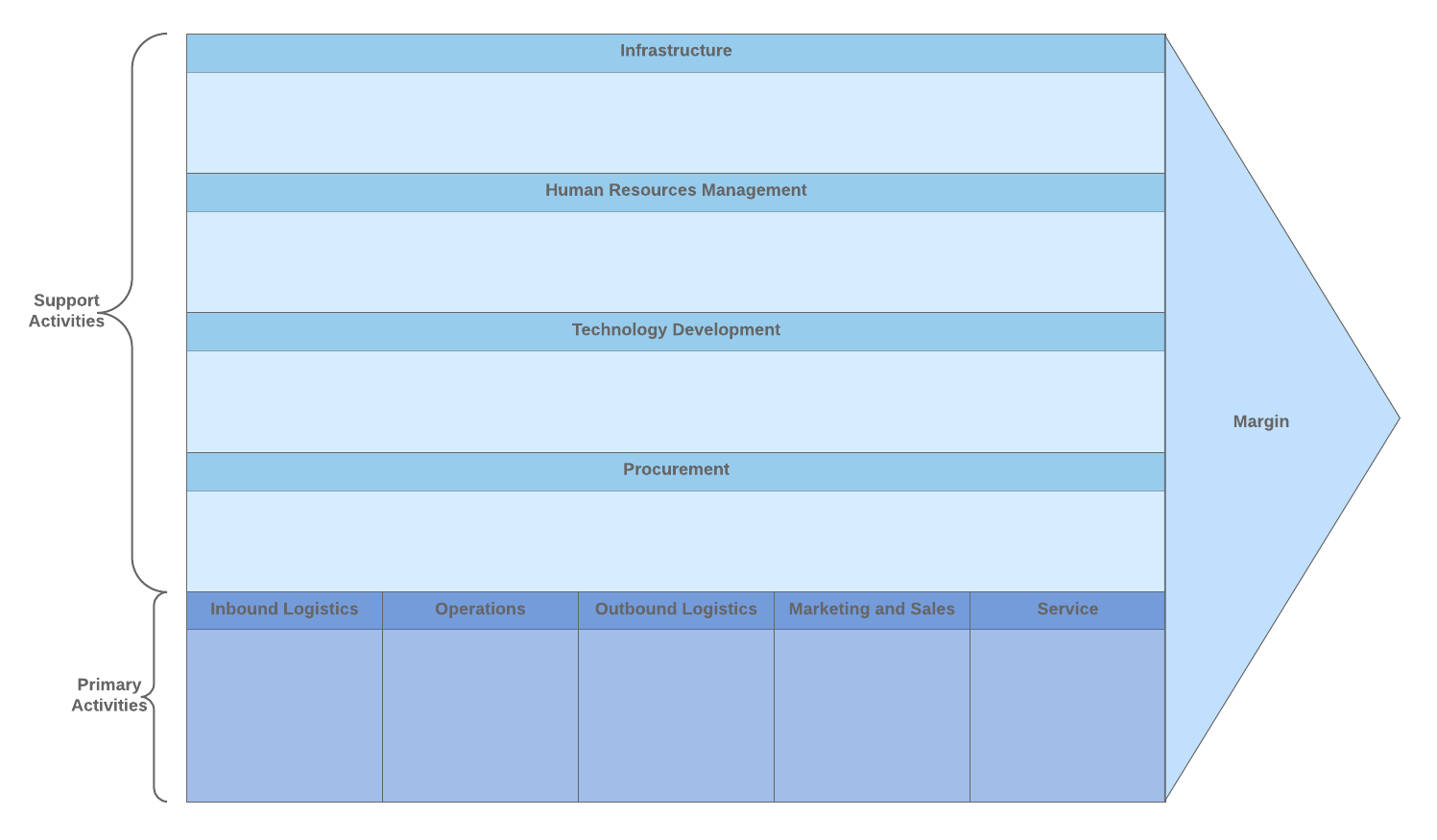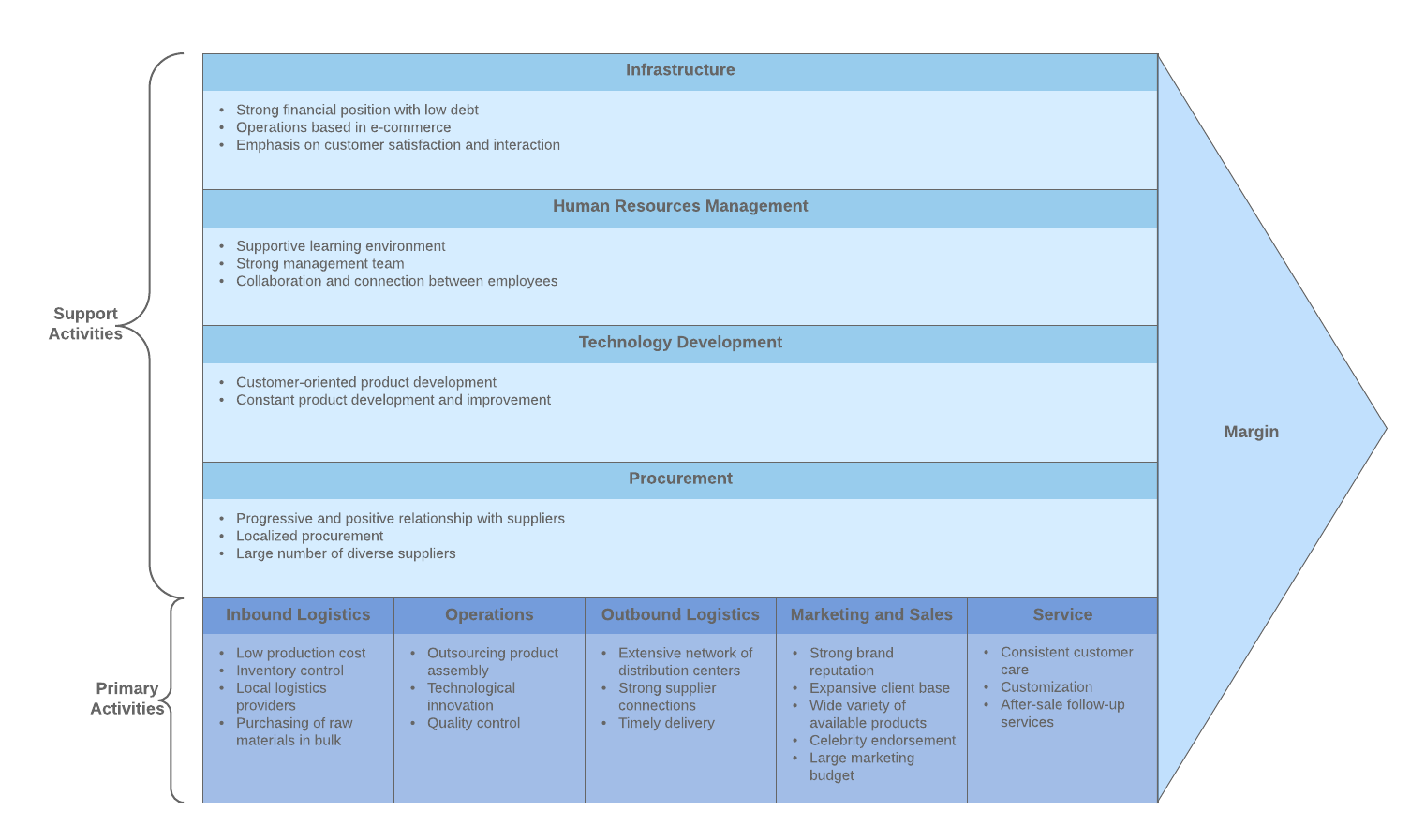
What is value chain analysis? Why it matters and how to get started
Reading time: about 6 min
The internet has given businesses access to the world’s largest customer base, but it’s also created unparalleled competition. Even the most niche businesses find that they have competition in the unlikeliest of places. However, you can still put your company at a competitive advantage when you complete a value chain analysis.
Learn how to conduct a value chain analysis so you can stand out from the competition, add value to your business, and solidify your company as a market leader.

What is value chain analysis?
A value chain analysis looks at the company’s processes at a granular level, rather than the company as a whole, to determine where value can be added.
Within the value chain analysis framework, first described by Michael Porter in 1985, companies identify primary and support business activities that contribute to its final product, visualizing each step of production, from conception to delivery. Then they analyze those activities to determine where the business can save money, increase efficiency, or maximize differentiators.
Value analysis versus value engineering
Value analysis and value engineering are sometimes used interchangeably. The objective of both value analysis and value engineering is to reduce costs and improve efficiencies across a product’s value chain. But the methods are applied under different circumstances.
Value engineering focuses on optimizing value before a product is developed. The purpose is to prevent unnecessary costs and value loss by building in those efficiencies during the design phase.
Value analysis, on the other hand, focuses on optimizing the value of an existing product. It’s a retroactive technique that reviews a product’s value chain to uncover cost-saving opportunities. Where value engineering is preventative, value analysis is remedial.
Elements of a value chain
According to Porter’s framework, all things that a business does can be divided into two groups: primary activities and support (or secondary) activities.
Primary activities are the activities that are required to create your final product, and they include:
- Inbound logistics: The process of receiving raw materials or parts from suppliers and storing and/or distributing those materials for the production process
- Operations: The process of converting inputs (raw materials, labor, and energy) into the final product or service
- Outbound logistics: The storage and distribution of your final product to distribution centers, wholesalers, retailers, and customers
- Marketing and sales: The process of targeting the product/service to the right customer group, promoting the product through various channels, and organizing a sales force
- Service: The activities required to keep the product or service working effectively for the buyer, such as installation, training, repair, and maintenance
Support activities help the primary activities to achieve a competitive advantage for the company. Some examples include:
- Technology development: Research to determine how the company can use technology to automate processes and develop new products
- Human resource management: The activities involved with recruiting, training, and retaining the employees needed to be successful
- Procurement: The sourcing of raw materials at the best quality for the budget
- Firm infrastructure: The activities involved with a company’s structure, management, planning, accounting, and finances
Include all the business processes that add value to your company, from recruiting to design to packaging to troubleshooting.
Benefits of value chain analysis
The goal of a value chain analysis is to learn how to create maximum value for your business and for your customers at the lowest cost. Without having a clear view of each activity in a business, recommendations for any improvements are based solely on conjecture. In fact, without conducting a value chain analysis, it’s difficult to determine if changes will add meaningful business value or if they’re just satisfying stakeholder whims.
By improving your value chain, you can also improve your company’s competitive advantage. You can stand out from the competition in two significant ways:
Being the lowest-cost provider: This is the “Walmart option.” If your aim is to reduce operational costs to deliver the lowest-cost product on the market, that goal needs to be the decision driver throughout your value chain analysis.
Being the most specialized provider: This is the “Nordstrom option.” If your aim is to create a unique product or experience, that should be the decision driver throughout your value chain analysis.

How to do a value chain analysis
Follow these steps to start your own value chain analysis (and click either of the templates above to follow along in Lucidchart).
1. Identify primary and secondary activities
Following Porter’s value chain model, your visual should include the following value chain components described above, divided into primary activities and support activities.
As you try to include all elements of the value chain, don’t be afraid to work as a team: You may need to lean heavily on leaders within departments who are in charge of each activity, as you’ll most likely not be familiar with the granular daily operations of each department.
2. Analyze business activities
Go back to your reason for undergoing a value chain analysis: Are you adding value based on specialization or on lowest cost? The decisions you make from here on out will be guided by this principle.
Link each business activity to the value you’re offering, and evaluate what your company needs to do or change in order to provide the greatest value.
For instance, fielding support calls may be one aspect of your primary activity of providing service. If you are being guided by lowering costs, you may determine that support calls should be outsourced to a call center provider and kept to the shortest amount of time per call possible.
However, if you are being guided by adding value through specialization, your company could improve the quality of each support call. Perhaps you implement after-call surveys to improve the quality of service. You’ll be looking at every single aspect of all the activities that make your business operate and determining where value can be added, either to lower costs and produce a lower-costing product or to focus on specialization and produce a more unique product.
3. Create a plan of action
As you can imagine, a value chain analysis will take a good amount of time, so be careful not to lose momentum during or after the process. After you have identified the value-adds, your business will need to actually incorporate those decisions.
Choose the easiest changes first. These changes can be visually identified on your value chain analysis model: you can star them, highlight them, or make them into their own flowchart. (The value chain diagram templates in Lucidchart make it easy to map your value chain and identify cost-saving opportunities).
These easy wins are important because they’re key to keeping the momentum going: Once your team sees the changes, they’re more likely to tackle the larger, more involved value-adds.
If you’ve identified changes that will make only marginal improvements but come at a great cost, it may not be worth it. Stick to practical, achievable changes that add mid-to-significant value to your business.
Prioritize the changes you plan on making and share these changes with stakeholders so you’ll have their approval and support.
Use Lucidchart for value chain analysis
Because a value chain analysis is such a visual endeavor, your business needs a visual platform. With Lucidchart, a cloud-based diagramming application, you can efficiently create a value chain analysis model that you can distribute instantly and keep updated in real time. You can also integrate your Lucidchart value chain analysis diagram into your favorite apps and create professional presentations for stakeholders with presentation mode.

Conduct a value chain analysis in Lucidchart.
Try it nowAbout Lucidchart
Lucidchart, a cloud-based intelligent diagramming application, is a core component of Lucid Software's Visual Collaboration Suite. This intuitive, cloud-based solution empowers teams to collaborate in real-time to build flowcharts, mockups, UML diagrams, customer journey maps, and more. Lucidchart propels teams forward to build the future faster. Lucid is proud to serve top businesses around the world, including customers such as Google, GE, and NBC Universal, and 99% of the Fortune 500. Lucid partners with industry leaders, including Google, Atlassian, and Microsoft. Since its founding, Lucid has received numerous awards for its products, business, and workplace culture. For more information, visit lucidchart.com.
Related articles
Understanding force field analysis
Learn about force field analysis and how Lucidspark can help. Weigh the pros and cons of a change and think about what you need to do to make change successful.
How a Workflow Analysis Can Dramatically Improve Your Productivity
Ineffective workflows can ruin your team's productivity and cost your company a lot of money. Max Benz from Filestage shares how to perform workflow analysis in order to identify the weaknesses in your process and start optimizing.
How to Conduct a Cost-Benefit Analysis
As your business grows, you will need to determine when and how to spend money on supplies, new equipment, new team members, and so on. Learn how to complete a cost-benefit analysis and determine where to spend your money for the best ROI.
How to conduct a 5 whys analysis
Stumped on a business problem? Try using the 5 Whys. By urging you to look deeper into the issue, the 5 Whys analysis can help you discover the root cause of a problem and put you on track to fix it.
